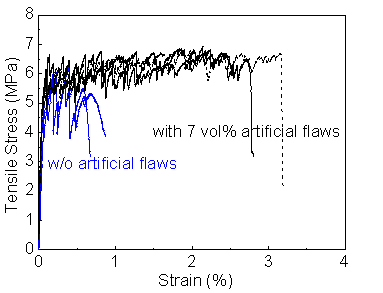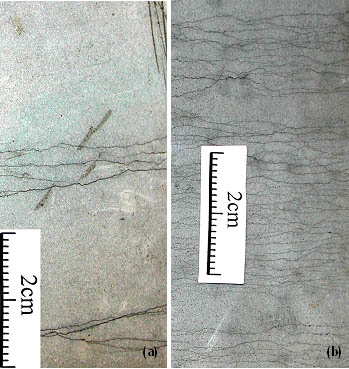The inhomogeneity of brittle matrix, i.e. flaws from micromechanical point of view, plays a significant role in the multiple-cracking behavior of ECC.
In a quasi-brittle material like mortar, flaws are typically where cracks are initiated. Although most flaws inherent from mixing process have sizes below 4 mm, which is rather smaller than the critical crack size inferred by linear elastic fracture mechanics, the existence of such flaws indeed considerably reduces the cracking strength from intrinsic material strength.
High ductility is closely associated with the density of multiple-cracking, and saturated multiple-cracking can only be reached when sufficient number of large flaws exists. However, the inherent flaws in cementitious matrix, e.g. pores, weak boundary between phases, and cracks induced by shrinkage, possess random nature and strongly depend on processing details and environmental effects. The number of cracks that can be activated before reaching peak bridging stress therefore may be limited and can vary significantly from batch to batch.
A practical approach to ensure availability of large initial flaws is by introducing artificial flaws with prescribed size distribution. The artificial flaws can be any particles with weak bond to the matrix or with low tensile strength. Expandable particles that can actively create micro cracks are preferred. The sample presented here uses low strength lightweight aggregates made from expanded shale. The aggregates have a graded size of 3.5 – 0.2 mm and the volume fraction is 7%. The effect of the tailoring on tensile ductility is clearly shown in Figure 1, as the strain capacity of the modified mix increases from about 0.4% to 2.5% on the average. Such increase is achieved by developing more closely spaced micro cracks. As shown in Figure 2, near saturated multiple-cracking prevails after adding artificial flaws, compared to very uneven pattern previously. Control of flaw size distribution also improves the robustness of ECC tensile behavior.
Fig. 1 Tensile behavior of PVA-ECC with and without artificial flaws
Fig. 2 Multiple cracking pattern of PVA-ECC: (a) w/o artificial flaws and (b) with 7 vol% artificial flaws


